Do you have a tree that seems to stick straight out of the ground like a telephone pole? If you can’t see the root flare, you have a tree planted too deep!
Table of Contents
Why is this a problem?
- Bark rot. Tree bark will rot if buried under damp soil. Not good for the tree.
- Suffocated roots. Tree roots generally grow horizontally and close to the soil surface so they can ‘breathe’. Buried tree roots will struggle to ‘find’ the soil surface and may never do so, resulting in eventual decline and early death (harsh).
How does a tree get planted too deep?
Trees often get planted too low by inexperienced gardeners. We have a few trees planted too deep – by me! My young and eager self didn’t know what I was doing. I had good intentions but poor execution. I sank the rootball lower in the ground to create a berm around the planting hole that would hold water. How dumb that sounds as I write it now. The berm held water as intended, but I should have set the tree base at ground level and built up a berm around that. Duh.
Additionally, the Hinoki Cypress tree in these photos suffered a second assault. Not only did I bury it too deeply from the outset, but it became buried even further when we hired landscapers to install a retaining wall. I planted this beautiful conifer on a slope, and now the slope was raised and leveled out, submerging the trunk area even more. There was no way around this other than to lift a rather mature tree out of the ground – not really possible without hiring pros to do it (read: expensive!). I probably should have added that item to the retaining wall project. Oops.
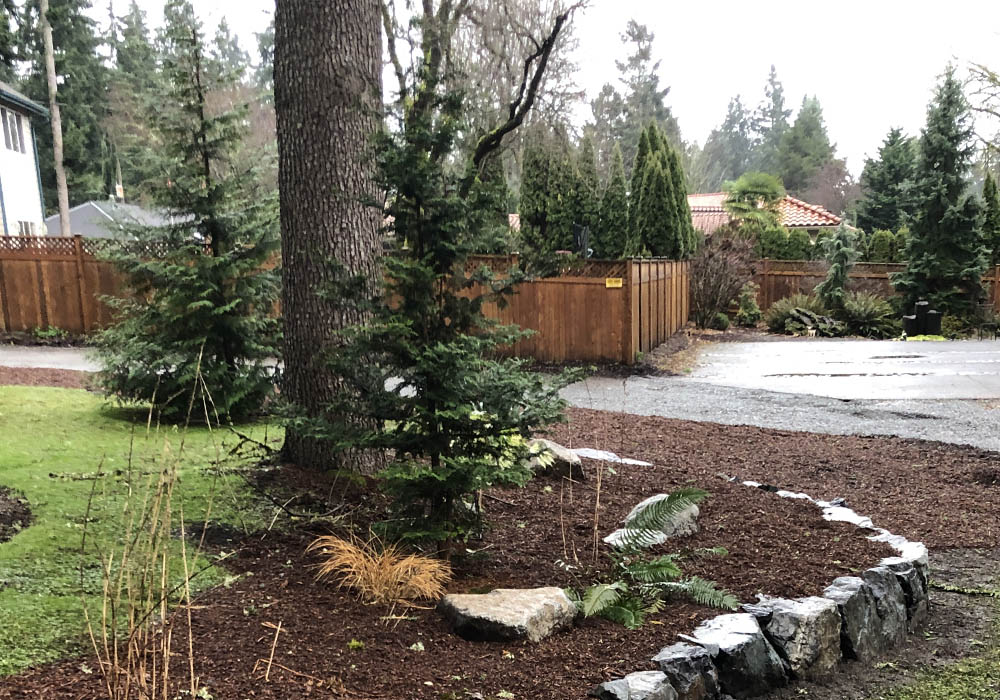
Wall completed and mulch applied! This doesn’t look significant, but it added about 5 inches of depth on the west side (right side in this photo) of the cypress tree trunk.
How did I save these sad, sunken trees?
Despite my repeated attempts to scoop material away from the tree trunks, it would inevitably build back up over time and wind and weather. I decided I needed a permanent solution, so last year I built a mini retaining wall on the high side of the slopes.
I started with the Hinoki Cypress. I dug out the uphill side about 1.5 feet from the trunk, low enough for the new soil base to be roughly level with the tree root flare. Then I dug out the area horizontally. Once I had a flattish soil base, I stacked 2 rows of bricks in a woven pattern on the uphill side. The resulting wall is arranged in a slight arc shape for stability.
Did I explain that clearly? Probably not; here are some handy illustrations!

I used standard red brick for the ‘wall.’ Our house is very old, and over time, I’ve amassed quite a collection of old bricks that I’ve dug up while gardening, so I had those on hand. (Why are there so many bricks in the ground? I’d love to know – they seem evenly scattered around our property.). But you could use stone, logs, or some prefab border material like interlocking bricks.
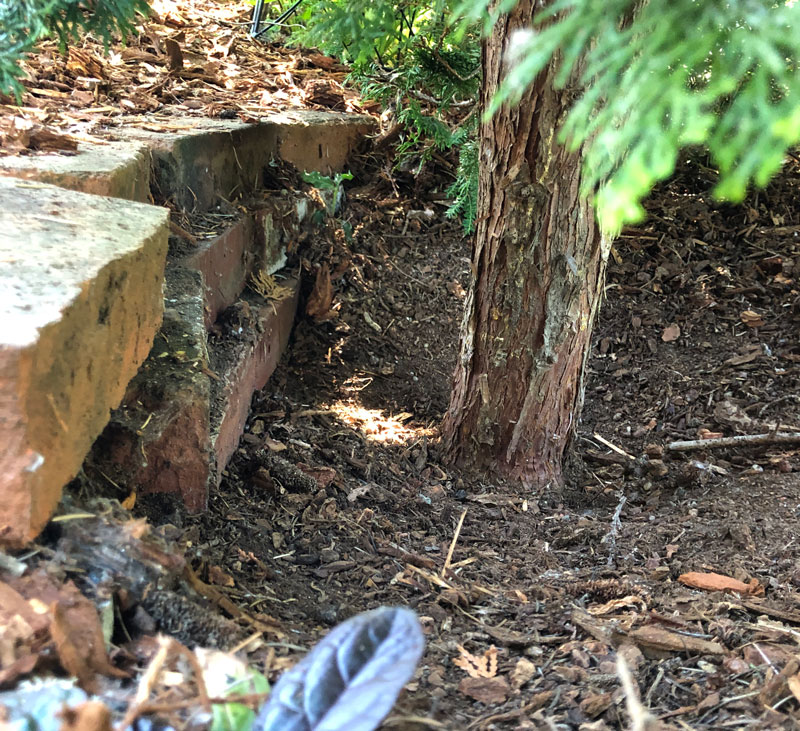
I’m pretty sure I had spiders in my hair after crawling into the shrubbery to get this shot. It shows a good view of the new grade.
My second specimen is this vine maple, which I planted on a slight slope of very soft soil behind our garage. Not only did I plant it too deeply to begin with, but it also sank after I planted it! Luckily, vine maples are native understory trees that can take some buildup of organic debris which it typically encounters in their natural environment. But this cultivar is grafted, and the graft union makes it extra vulnerable, so I had to fix this tree too.

My rescue effort for this Pacific Fire Vine Maple only required one stack of bricks. Pacific Fire is a grafted cultivar (you can see the knobby graft in this photo), and it’s essential to keep any graft free from debris.
Success! And a caveat.
So far, these two trees are thriving, the Hinoki Cypress having been in the ground for 6 years and the Vine Maple for 5. Note that this excavation will help keep mulch and soil away from the trunk and prevent rot; however, your tree may still struggle with root suffocation depending on how deeply it’s buried and how long it’s been in the landscape that way.
This retaining wall method is an inexpensive solution for smaller trees that have been in the ground too long to move. Will they eventually succumb to root suffocation? Perhaps, but I’m very optimistic.
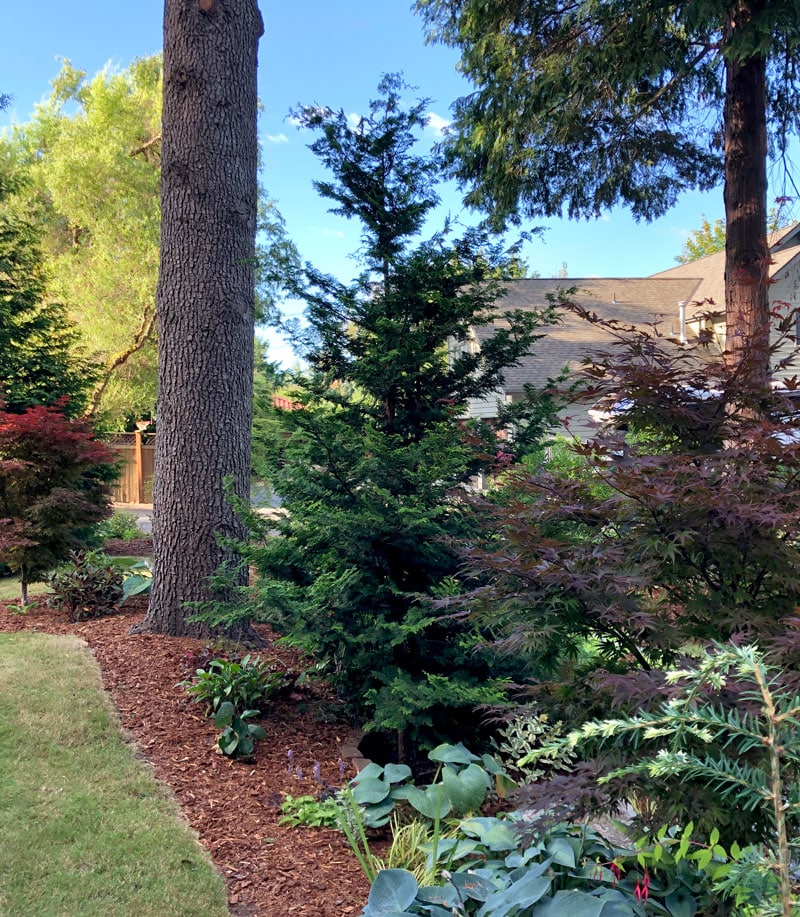
The Hinoki Cypress and surrounding garden look healthy and elegant compared to the previous photos taken 3 years ago.
Alternative solutions for saving a tree planted too low
Depending on your situation, there are a couple more surefire ways to tackle the issue.
- Dig up and raise it. If the tree is small enough for you to handle and/or has been in the ground for less than a year, simply dig it up, add some soil to the bottom of the hole, and replant it so that the root flare is level with the ground. This method sets the tree back a year in terms of getting established but is best in the long run. (I successfully used this method for a Paperbark Maple and Tricolor Beech, 2 other victims of my novice gardening practices).
- Replace it. Admittedly this is not saving the tree, but it will save you the heartache of watching a tree die. Replacement is the best solution if the tree is already in decline or you want to make a garden edit anyway. Get the doomed tree out of there and start fresh. Clearly, this is not the cheapest option, but if your tree is dying, it’s better to rip off the bandaid and get a new tree planted and established. Future you, who is enjoying a nicely maturing new tree, will thank present you.
Tips for planting trees at the right depth
And the very best solution is to do it right in the first place! It might seem obvious: just plant the tree so the root flare is level with the soil’s surface. However, there are some gotchas to look out for:
- Sometimes nurseries sell trees already planted too deeply. You would think nurseries would get it right, but it happens. When plants are up-potted – say from a plug to a 1-gallon – nursery workers may add too much soil to the top of the pot. This can happen several times as the tree grows and is moved to larger and larger containers. In fact, I recently purchased a not-inexpensive, mature Japanese maple buried 2 inches too deep in its 10-gallon container. To rescue trees like this, check the root ball to find the root flare and remove the soil until it’s level.
- Trees can sink after planting. How much depends on your soil and the nursery’s growing media. If it can compact, over time, it will. If you dig the planting hole too deeply and need to backfill it with soil to get the root ball up to the correct height, make sure to compact the backfilled soil a bit to create a solid base.
- Mulch can become the new ground depth. I mean that by piling mulch too deeply around the tree, you create the same conditions as a tree that is planted too deeply in the first place. If too much mulch is added over several years, that mulch breaks down and forms a solid mat of soil-like material that can rot the tree trunk and bury roots. When mulching, mulch lightly around the tree and keep all mulch several inches away from the tree trunk.
I hope these tips help you avoid my mistakes as a beginning gardener. And if you’ve already made them (like I did), I hope the retaining wall solution and other ideas for saving an over-planted tree work for you.
What do you think of this retaining wall idea? Did you try it, and did it work for you? Let me know in the comments!


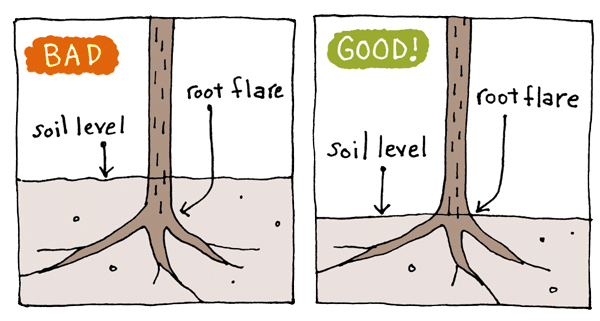
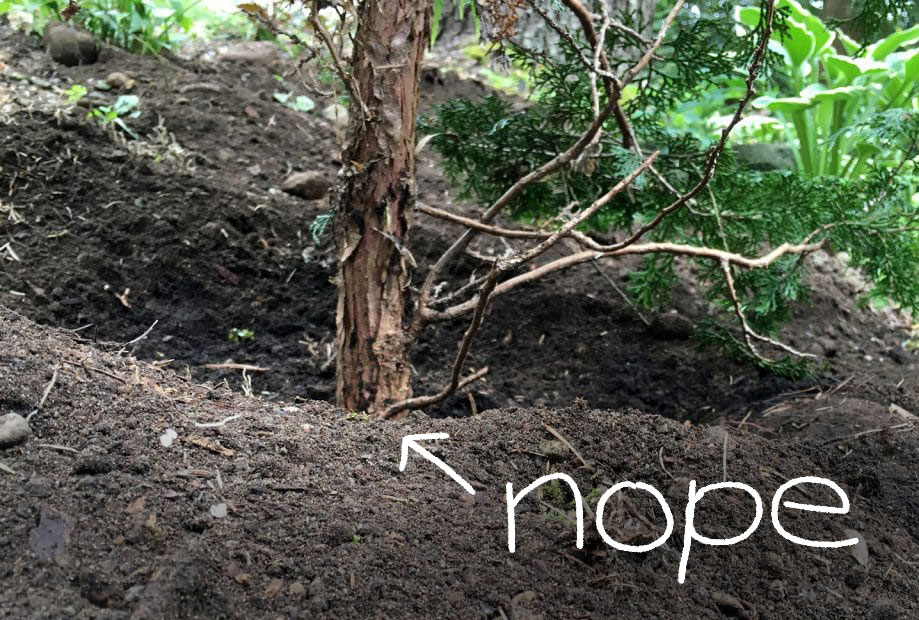

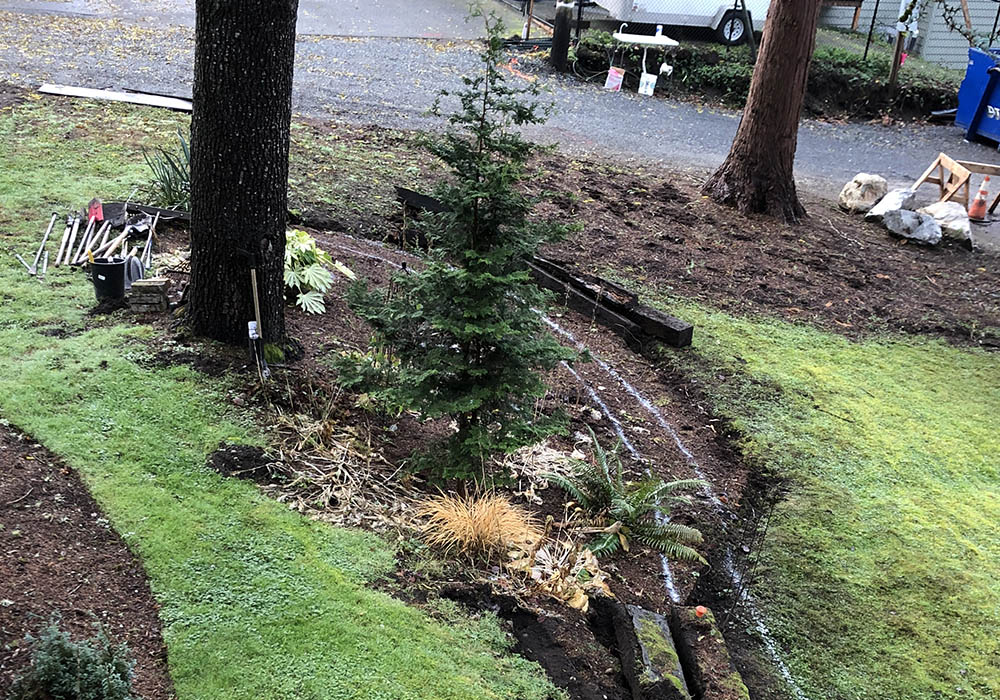


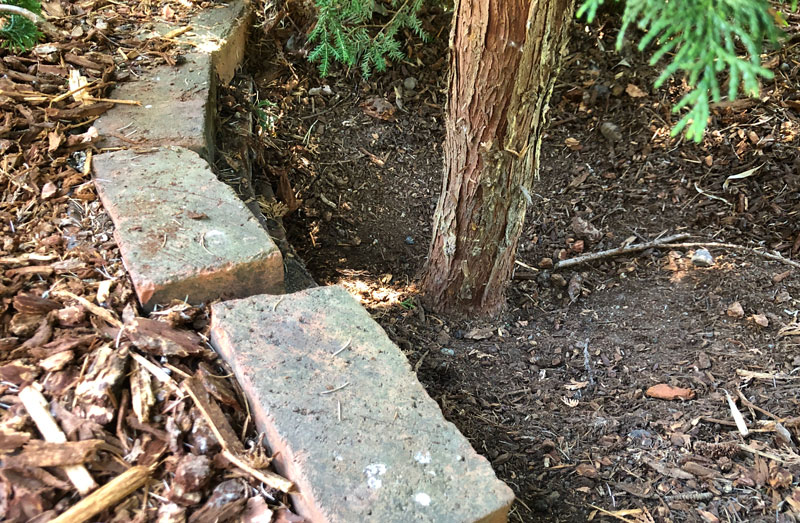
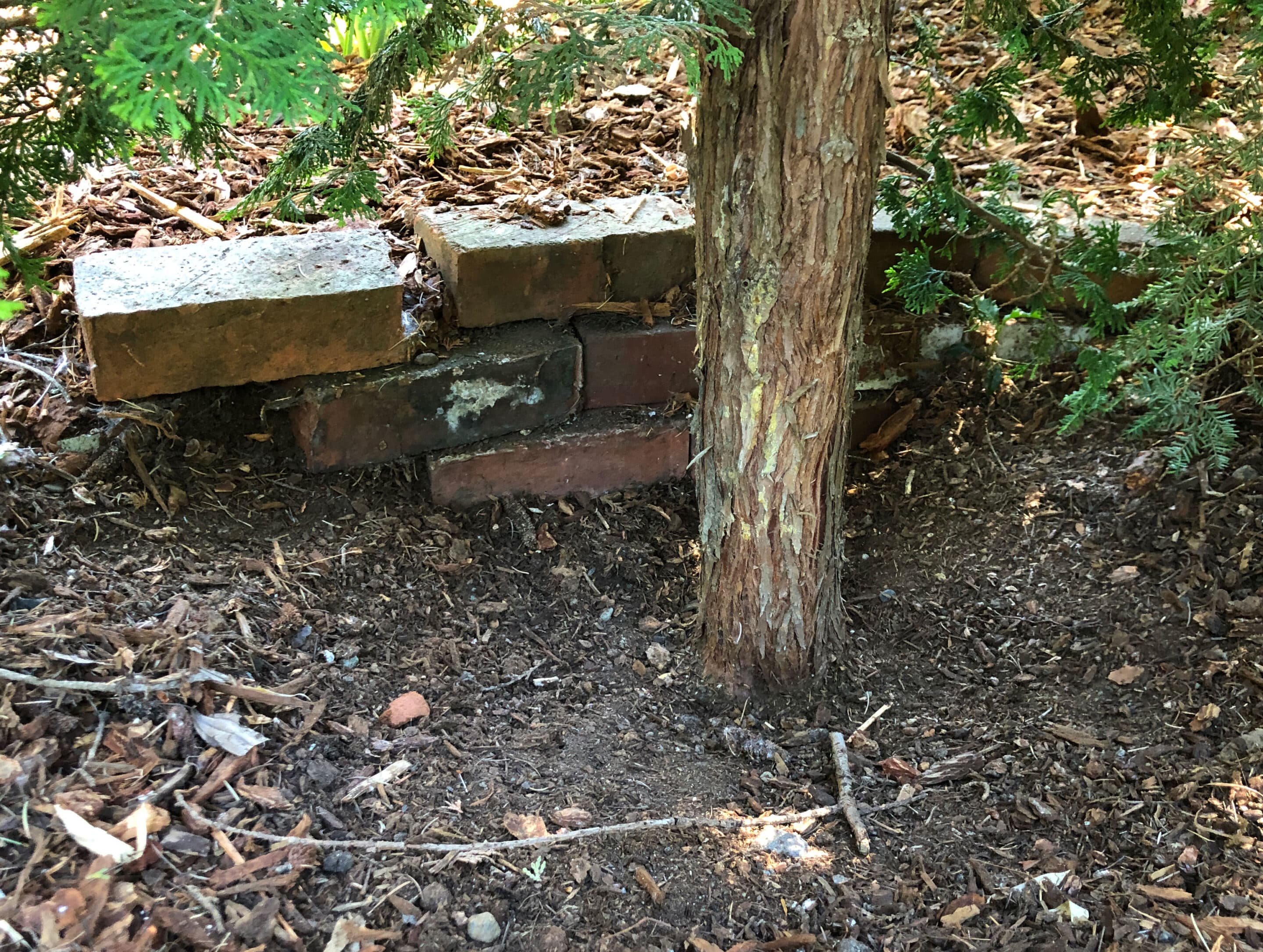
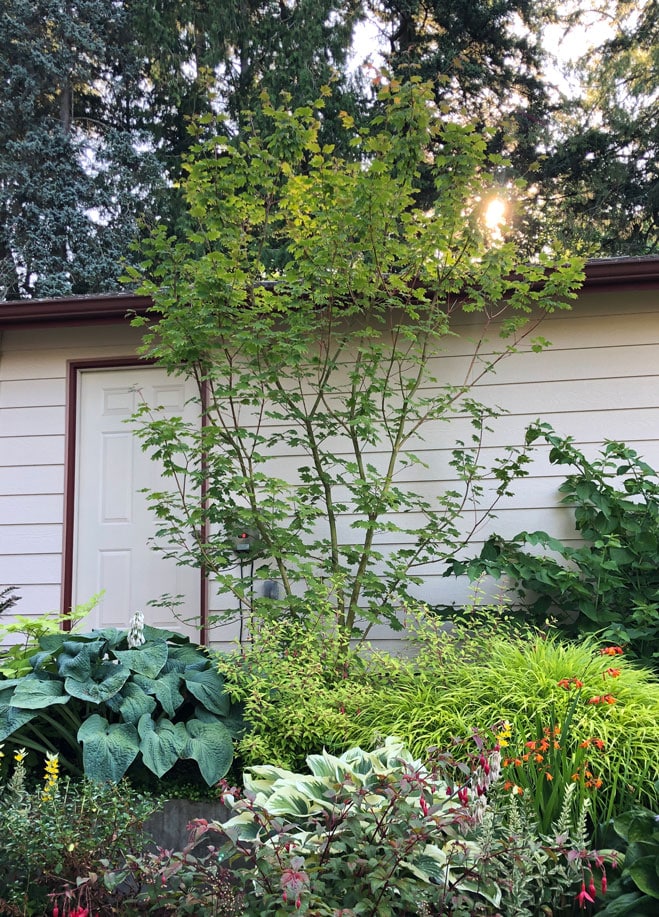
Interesting, however, not all trees tree suffer from being planted too deep. I am a professional pomologist with 45 years experience as an advisor to commercial orchardists. I am also a past ISA member. Apple, pears and other fruit trees do not suffer from planting too deep unless there is a drainage problem. If a dwarfing rootstock is part of the tree planting the graft union below grade will result in scion rooting and loss of the rootstock’s dwarfing. This is a very common issue with home owners and small orchardists. The rootstocks for these trees have been traditionally propagated by stool bed, a technique that utilizes the ability for buried parts to produce roots. There are other tree besides fruit trees that have this characteristic. Unfortunately because of information like you have presented has lead to web garden gurus stating that fruit trees must not be planted too deep or be mulched to deeply or their bark will rot. This is completely incorrect, but, if they have no background with trees and they are presented with unbalanced or incomplete information, they sure what they are saying is correct when it isn’t.
Hi Richard, thanks for your comment, great to know this about fruit trees! I’m a recreational gardener so I’m delighted when experts weigh in, thank you!
Thanks for this❕ I just planted 2 persimmons at the soil line. The trees are 2-3 years old and grafted.
Is this OK
I live in LA. This article is right on. People who call themselves “professionals” routinely plant citrus trees up to 6″ too deep – sometimes to make up for the fact that they have destroyed the root ball in transit and are trying to get the tree to stand up straight. The tree limps along for years with no growth, and even arborists seems to be stumped as to what is wrong. Until you dig down and find the root graft underground. If not for internet articles and videos (like this one), I still wouldn’t know what the problem was.
Not understanding the fundamentals of this article have cost me 10 years of lost growth and productivity.
Richard,
I have an ivory silk lilac planted about an inch too deep.
It’s entering its third summer, and is about 10 feet tall.
The root flare becomes visible with top soil scraping, but gets re-buried over time. There is some die back but this spring it’s looking better than last spring foliage wise.
Could it be lifted/re-set? Would live to save it.
Ron, It is always best to replant the tree properly then to “deal with it” by having to put time and labor into managing something that can be prevented in the first place and is the best investment for the health of the tree. Raise it up. Othewise it’s just in chronic survival mode, never able to thrive.
If you want to give your tree the best chance of thriving:
Remove grass (and grass roots) from under the tree canopy to a foot beyond the drip-line of the tree. Grass competes directly with tree roots. And tree roots go out sideways 3–10 times the height of the tree all the way around the tree. In your case, remove the grass and its roots two feet all the way around the tree to start with.
Do it in mild weather, best case scenario in the spring on an overcast day with little wind and rain on the way. Otherwise in the evening to to avoid sun and wind and give it a rest.
When digging a planting hole, do NOT dig lower than how deep it is in the pot. It is more important to go OUT than down and create sharp angles like a star to catch roots rather than to dig a bowl that will encourage the roots to stay in the bowl shape. You want a mound of soil to plant onto, not a bowl to plant into. Do not amend the soil.
Use this root washing technique:
https://gardenprofessors.com/why-root-washing-is-important-an-illustrated-cautionary-tale/
Make sure the trunk flair is exposed to air above the soil line when planting and know that the tree will still settle lower. If the tree was planted too low (most of them are) excavate the soil away from the trunk of the tree until you expose the main root flare.
https://marylandgrows.umd.edu/2024/01/12/free-the-flare-maintain-visible-root-flare-for-tree-health/
Add a one inch layer of organic compost in a flat circle like a Saturn ring around the tree. Make sure there is a 6- 8 inch ring of bare soil around the trunk flare.
Water well.
Top the compost ring with 3 inches of woodchip mulch. Start 9 inches away from the trunk. No mulch should be near or touch the trunk. Spread it flat all the way out to cover the compost.
Water well.
Compost helps trigger soil microbes to do their jobs (ecosystem services). Mulch is a blanket over the compost that moderates the soil temperature, prevents the soil from drying out, therefore requiring less watering. It’s best NOT to use black mulch, use mulch that has not been dyed any color.
As the tree continues to grow, keep removing the grass to match at least the dripline of the tree and add compost and mulch.
The tree will need extra care and water for the first three years because it takes a minimum of three years to get established.
Hi Richard,
Your information on trees planted too deep brings me hope. I have a pear tree planted about 8 inches below soil level. I have cleared the dirt around it to expose the tree crown. Do I have to raise this tree up?
Hi, Glad i found your webpage.
We have a mature magnolia tree and mature 5-6 meters Jacaranda in our garden, 2 years ago we built a garden bed and topped the soil. Now the trees are not looking very healthy.
I have an idea to dig around the base like the second picture in your post “pit of doom”.
May i know why this is not a good idea?
There are smaller roots growing in the base of the trees, does it mean that the trees somehow adapted to the new level of soil? or this is actually bad news?
Thank you,
Hi Frank, it sounds like those trees may have adapted – if they are mature I would consult a certified arborist to have a look! Thanks for your comment (and sorry for the delayed reply 🙂
Lori:
You mentioned: “Sometimes nurseries sell trees already planted too deeply.” There is a document by Ellen Vincent, Principal Lecturer, Horticulture Environmental Landscape Specialist, Horticulture Program Team, Plant and Environmental Sciences Department with Clemson University who has citations stating it is 75% of nurseries selling trees planted too deep with 93% of all “professionally planted trees” are planted too deep.
Made worse by non-professionals who are at best taught to “plant at the same soil line” as it was in the pot which works for annuals and forbs but not for trees due to how they are commercially propagated and managed.
This is a multiple-industry-wide problem. Made exponentially worse for nurseries to this day instructing customers to bury the graft union.
Richard’s comment above “If a dwarfing rootstock is part of the tree planting the graft union below grade will result in scion rooting and loss of the rootstock’s dwarfing. This is a very common issue with home owners and small orchardists” simply re-iterates the importance of simply planting the tree so the main root flare is showing.
Trees planted too deep is one of the most common inside jokes and income makers for certified arborists who have to take the trees out. They see this problem **all the time** and they have to deal with removing large trees that fail as a result of it.
Look at trees in nature where humans are not involved, the root flare is obvious.
Suggestions for improvement for the photos of your own trees, remove the mulch around the trunk so it is bare soil. Mulch should never go up to the trunk, give it a good 8 inches of bare soil so it doesn’t create habitat for trunk boring insects or critters and it keeps the bark dry. Really you could expose even more root flare for all the trees you showed.
Thank you for posting about an important and little known tree planting essential.
If a fruit tree is planted with root flare below ground level will it make new roots at the soil surface and fix the problem ?
The first comment by Richard Hallman seemed to suggest that. Sorry if I’m misunderstanding.
He said apples and pears don’t suffer from being planted too deep.
I hope that stone fruit (plums, nectarines, etc) are also forgiving of being planted too deep ?
Very interesting what he said about propagating by intentionally covering the tree trunk with soil.
Hi Christine, I believe Richard is saying that if the tree is buried so that the the soil line is above the graft, then the grafted, upper part of the tree (not the original rootstock) can start to grow roots. He doesn’t say if an ungrafted tree would grow new roots. Hopefully he will come back and chime in on your question about stone fruit trees, I’m not sure if those would be included in the ‘other fruit’ trees category. Hope this helps!